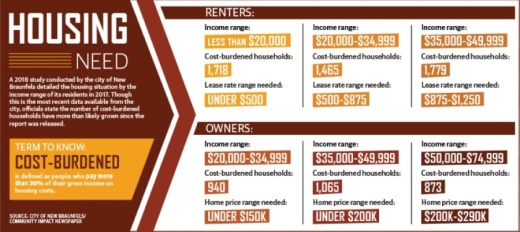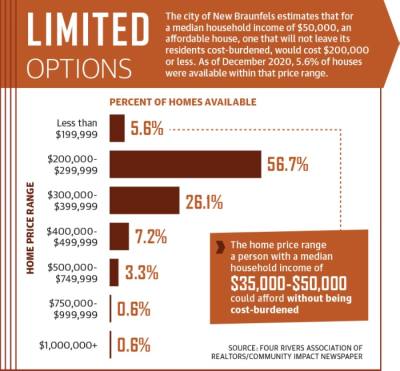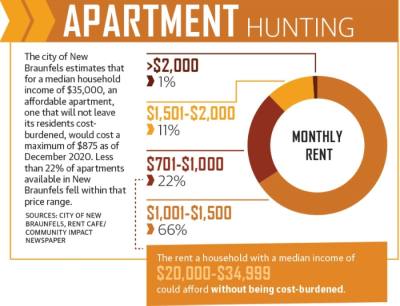When it comes to her living situation, Christina Quintanilla considers herself lucky.
Because she is renting her three-bedroom, two-bathroom home in New Braunfels from family members, she said she is paying well below the market rate.
That is likely to change in the near future, however.
Quintanilla is renting her grandmother’s house, which she said is more than 60 years old, and the family tie accounts for her discounted rate of $950 per month.
Due to recent increasing expenses within her family, Quintanilla said she is expecting her rent to go up closer to what she estimates the market value for her neighborhood, square footage and home age—$1,250 or so per month.
“As a single mom, a one-income household, it’s difficult here, especially if you think you’re going to work here and make enough money,” Quintanilla said.
With regard to the cost of housing in New Braunfels, Quintanilla’s is a situation that is growing more common.
To that end, city staff and officials have recently made the creation of more attainable, affordable housing, what they call workforce housing, a top priority in 2021.
Policy implementations being examined include residential zoning adjustments, reviewing regulations that inhibit housing options and incentivising affordable housing, according to city staff.
Jeff Jewell, New Braunfels director of economic and community development, said a good rule of thumb is that households should not spend more than 30% of their gross annual or monthly income on housing. Those who do are considered cost burdened, which describes one out of three households in New Braunfels.
Defining the problem
As the only source of income in her household—Quintanilla lives with her two children—she said she is not cost burdened now, but she will have to make some adjustments once the rent hike takes effect.
“I feel that I may make more [money] than a typical single mother,” said Quintanilla, who works as a research analyst for a college district. “How somebody does it on a limited income, I don’t know.”
Should Quintanilla’s rent go up this year to the level she expects, she said she will easily surpass the threshold of paying more than 30% of her gross income on housing.
It remains a goal for city leaders to find more options for what they call workforce housing, and Jewell said those in the workforce demographic are defined as people earning between 30% and 80% of the area’s median household income. In 2019, median household income was defined as $71,044 for a household of four, according to the U.S. Census Bureau.
For the same size household, 80% of the area’s median household income would total roughly $58,000 per year, Jewell said. He added that as housing costs continue to rise in New Braunfels, it is becoming increasingly crucial that city leaders work to provide more attainable housing options.
The rising cost of housing locally is an issue that is becoming more and more visible in the community. As an administrator for a Facebook group called Moms of New Braunfels—as well as the CEO of an area nonprofit called Light Work 316 Inc. that helps families hit by untenable medical expenses—Abbie Maberry said housing is a prominent topic among those who post in her group.
About 10,000 members strong, Moms of New Braunfels is a forum for myriad topics, but Maberry said she sees at least five to seven posts per week from mothers seeking housing they can afford.
“We have a lot of moms who say things like, ‘I can’t afford anything more than $1,500 a month in rent. Can someone point me in the right direction?’” Maberry said. “It’s a pretty continual request, because it’s just known for most of our members that the housing market in New Braunfels is just kind of exorbitantly high right now.”
More affordable options
On top of the rising cost of home ownership in New Braunfels, data from Rent Cafe, a national price aggregation company, shows that the average cost to rent a living space in New Braunfels has gone up about 3.3% since November 2019 and as of January is at $1,223 per month.
Though the national average of $1,464 per month is higher, that rate has actually decreased by 0.61% from November 2019 when it was $1,473.
With housing costs increasing and the city’s population growing rapidly, Jewell said it has become even more important to create more attainable housing options.
According to a 2018 workforce study conducted by the city, the three areas of New Braunfels’ employment sector that showed the most growth at that time were retail trade and accommodation, social assistance and food service.
As of the first half of 2020, data from the Texas Workforce Commission showed those industries were still among the fastest growing in Comal County.
On Jan. 14, the city and the New Braunfels Chamber of Commerce held an informational online presentation on missing middle housing—a concept that focuses on integrating more affordable living options into existing and new neighborhoods that are also walkable.
This project was in large part an initiative from the Workforce Housing Advisory Committee, a body that works with city officials to develop plans to improve opportunities for workforce housing in New Braunfels.
Dan Parolek, a principal at Opticos, a national team of urban designers, architects and strategists who work on community housing solutions, led the Jan. 14 presentation for city leaders and residents.
Missing middle housing, which includes options that fall between single-family units and large apartment complexes—duplexes and fourplexes, for example—was popular during the early and mid-20th century, Parolek said, but since the 1990s it has lost its foothold in many communities throughout the country.
“This idea of missing middle housing really gives communities like [New Braunfels] the opportunity and the tool set to talk about these broad range of housing options without using ... very loaded terms like high density, which people often respond very negatively to,” Parolek said.
With regard to why missing middle housing is such an important concept for communities like New Braunfels to consider, Parolek said one reason is that nationally about 30% of households today are single-person.
Another factor is that households are shrinking throughout the country, and by 2025, 75%-85% of households will not have children living in them.”
So, that nuclear 1950s or 1960s family with a mom and a dad and two or three kids is changing,” Parolek said. “That’s not actually the norm now.”
Other housing assistance options
The city is not curtailing its pursuit of more federally subsidized affordable housing, evidenced by a September approval from City Council of an application for a 336-unit low-income housing complex.
The 13-acre Oak Creek multifamily housing project would be located at the corner of Oak Creek Way and I-35, and it would be restricted to households earning up to $72,000 for a family of four, according to LGD Development, the project’s applicant.
LGD representatives stated the project could be move-in ready by spring 2022, but as of January, the company had still not submitted an application for the housing project.
Aside from the potential Oak Creek project, information from the New Braunfels Housing Authority states there are two other public housing projects in the city—the 100-unit complex called Laurel Plaza and the 70-unit complex called Villa Serena.
“I would describe our public housing as one facility at two different sites,” said Henry Alvarez, executive director of the NBHA.
Alvarez added the NBHA also supplies 240 vouchers to the private marketplace for families in New Braunfels, and information about qualifying and applying for assistance is on the authority’s website.
In addition to the units and voucher system managed by the NBHA, Jewell said New Braunfels also has at least three other federally subsidized housing projects whose owners and investors receive tax credits in exchange for their investments in the properties.
With regard to city initiatives designed to help residents struggling to make their rent or mortgage payments, the city has allocated upward of $191,000 to go toward a Comal County program designed to help residents financially affected by COVID-19.
However, he added a city-sponsored initiative to help residents with cost-of-living hardships does not exist at this time.
Jewell pointed out there are options for people needing rent assistance through local nonprofit organizations, and information for those programs can be found at www.comalcountycares.com.
Still, he said a key goal for the city is more long term. It is to drastically reduce the number of residents who are cost burdened but also do not qualify for federally subsidized housing.
To facilitate this goal, it is important to continue public discussions of the housing issue at hand, he said.
He added that specific actions involving revision of regulations that inhibit creative housing options and workforce alternatives are likely coming down the pipeline to City Council very soon.
Working toward more official buy-in
There are already signs that installing the procedural infrastructure needed to implement concepts such as missing middle housing might take longer than city staff initially thought.
During a Jan. 5 New Braunfels Planning Commission meeting, the body discussed extensively an item on amending regulatory barriers to workforce housing.
After being presented with a couple of options for easing restrictions on duplex lot sizes and what are called live-work units, members of the commission expressed numerous concerns ranging from maintaining a neighborhood’s character to there not being enough clear information on the proposed amendments.
Jewell said he understood the trepidation from the commission, and the January meeting was an early signal to him that much more work is left to do with regard to gaining buy-in from city leaders.
Still, Jewell said the city’s goal remains to ease the growing cost of living burden in New Braunfels.
“If folks can get into a more stable housing situation, it tends to bring benefits to the community as a whole, which is why the public sector typically takes an interest in pursuing some level of broader affordability for folks,” he said.









